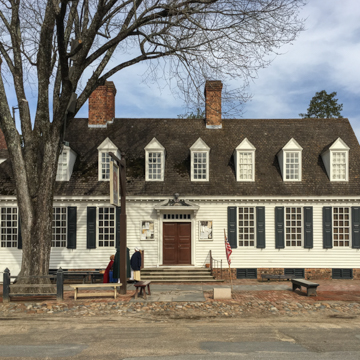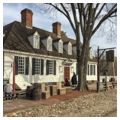Among the largest taverns in eighteenth-century Virginia, the Raleigh is most famous as the site where burgesses met, in 1769 and 1774, after two successive governors dissolved what they perceived as rebellious general assemblies. Lafayette was feted with a banquet in the Apollo Room on his nostalgic return to America in 1824. These and other activities—Jefferson wrote of a “wretched” hangover after a night of dancing there—illustrate the Raleigh's role of providing entertainment and meeting space for hire. As such, the Apollo and Daphne rooms were the counterparts of private entertaining rooms like the ballroom and supper room at the Governor's Palace and the dining room at Peyton Randolph's house. Creation of such spaces was a chief reason for enlargement of the tavern, just as it was at the executive residence, Randolph's house, and other large houses and taverns.
The Raleigh was destroyed in 1859. The reconstructed tavern was the first building of the Williamsburg restoration, opened to the public in 1932. Perry, Shaw and Hepburn were able to base the form of the building and its room arrangements on the archaeological footprint and two 1848 engravings by Benson Lossing, but they drew most of the interior details from eighteenth-century Virginia houses. Woodwork was more richly applied here than in later reconstructions, relative to the rooms' functions, so the building has a freer Colonial Revival quality than later reconstructed buildings in the Williamsburg historic area.




